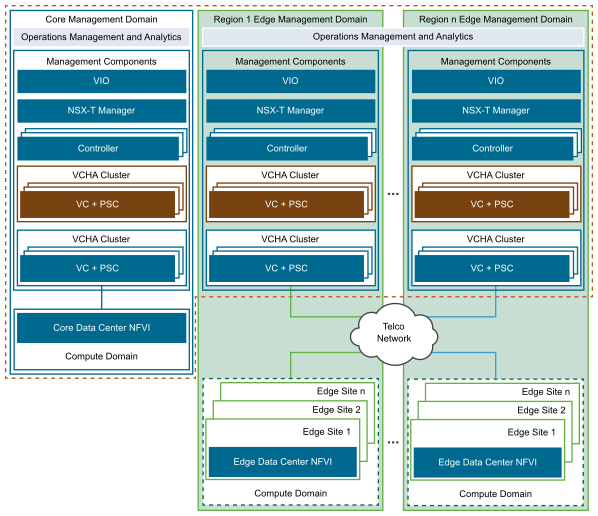The Core data center is used to house the management components and other NFV functions that need to run at a central location. In the context of this reference architecture, a Core Data Center continues to run the core NFVi functions while also hosting the management components to manage the various telco edge sites.
Physical Configuration
The Core site follows the three-pod design used in the vCloud NFV 3.x Reference Architecture and includes a minimum of three hosts (four recommended) in the management pod and the Edge pods. The resource pods comprise the hosts in the remote sites and any local clusters related to operations and functionality of the Edge sites.

Logical Configuration
This section describes the architecture for the Core data center to manage the Edge sites and to backhaul traffic from them.
The management domain comprises the Virtual Infrastructure Management (VIM), vCenter Server Appliance, NSX Manager, and NSX Controller. In addition to the management domain components, the Core data center also contains the operations management components. For more information of the operations management, see the Telco EdgeAnalytical Architecture section.

In the preceding figure, the brown colored vCenter Server blocks are responsible for managing the components of the respective management domains. It is the entity used to create and spawn off the other management components in this cluster such as NSX Manager, NSX Controllers, and vRealize components. The left side of the diagram under Core VIM is infrastructure used to manage all resources in the Core data center. The right side of the diagram indicates the management components that are used to manage a group of edge sites within a region. The Region 1 Edge Management Domain manages a set of edge sites in Region 1 (shown connected through the Telco network) and Region 2 Edge Management Domain manages Region 2 edge sites and so on.
This Edge reference architecture consists of two sets of VIM components. One component is used to manage the VNF workloads deployed in the Core data center, while the other is used to manage the Edge sites within a region. Each edge site is a vSphere cluster (resource and edge pod) that can be scaled up as needed by adding ESXi hosts. The separation of Core data center and Edge data center resource functions into individually scalable pods allows CSPs to plan capacity based on the needs of the specific function hosted by each pod. This provides greater operational flexibility.
For best practices when using vSAN as the shared storage solution for the Core data center, initial deployment requires a minimum of four hosts per cluster. This sizing recommendation provides balance between the implementation footprint and resiliency, while maintaining the operational requirements necessary for the site.
The Resource and Edge clusters at each site are sized in accordance with the VNFs and their respective networking requirements. CSPs must work with the VNF vendors to gather requirements for the VNF service to be deployed. This information is typically available in deployment guides and sizing guideline documents.
The number of remote sites under a single Region can vary depending upon the size of the Edge sites and the number of local clusters in the resource pod. For detailed configuration maximums click here.